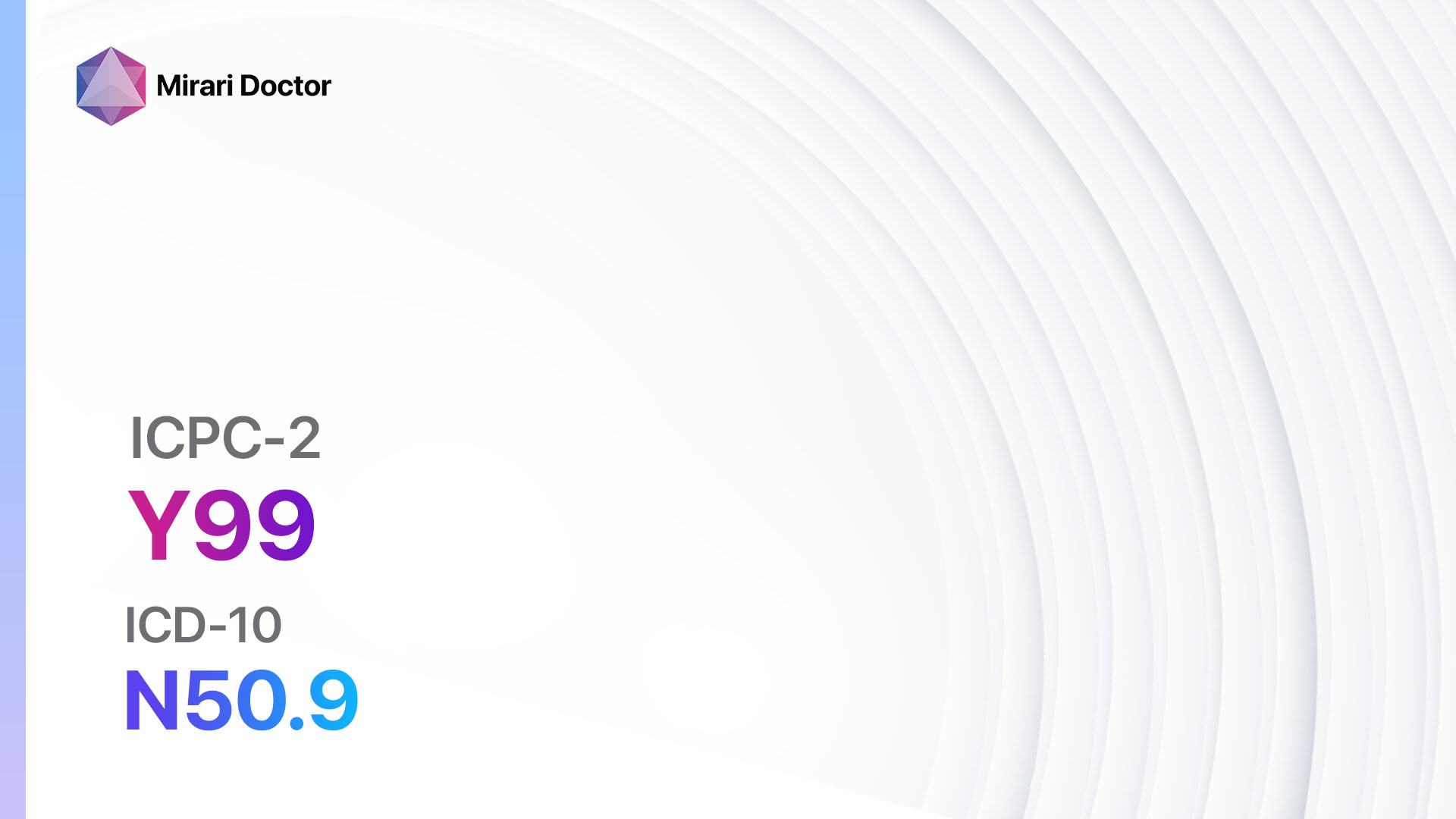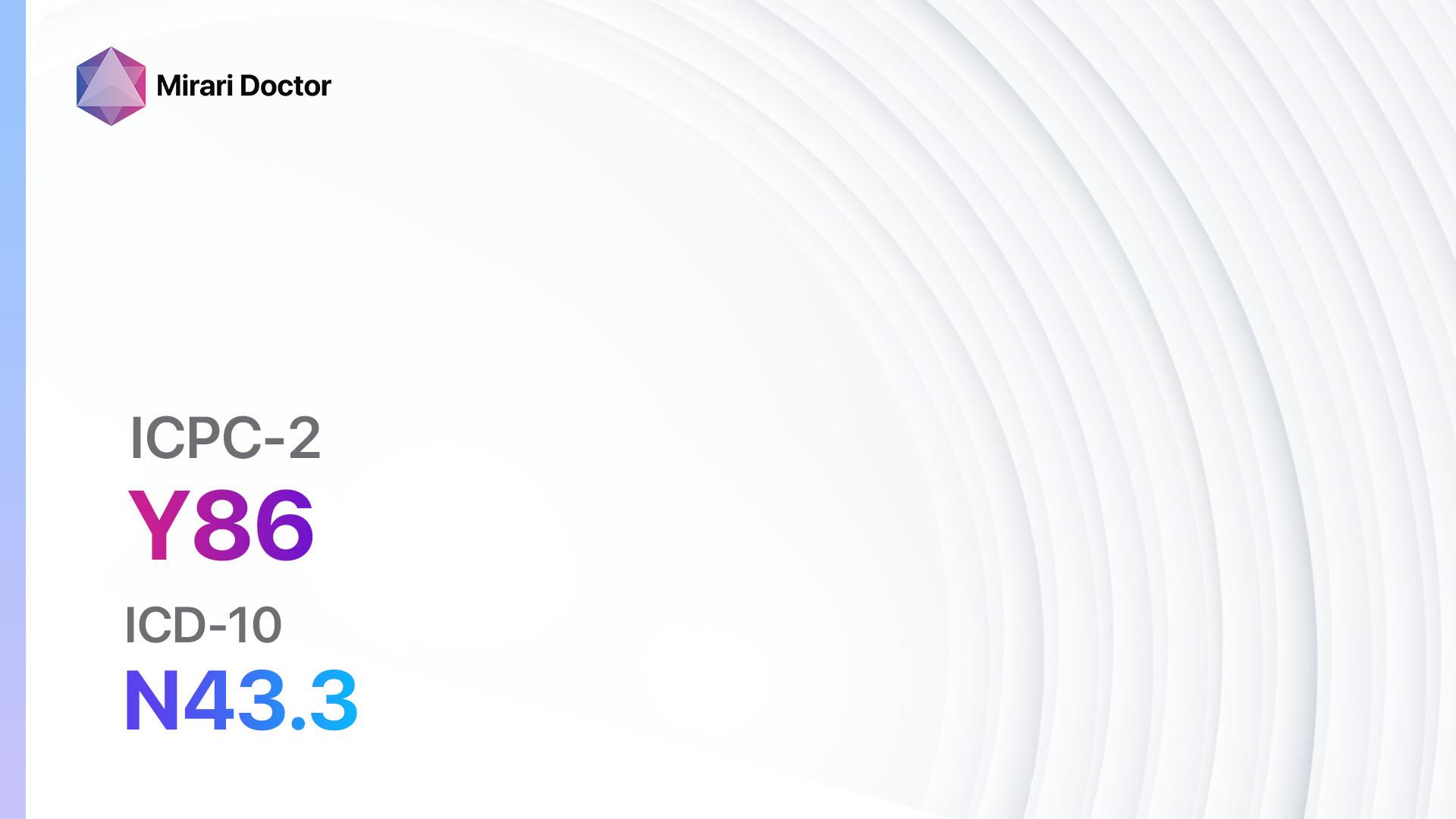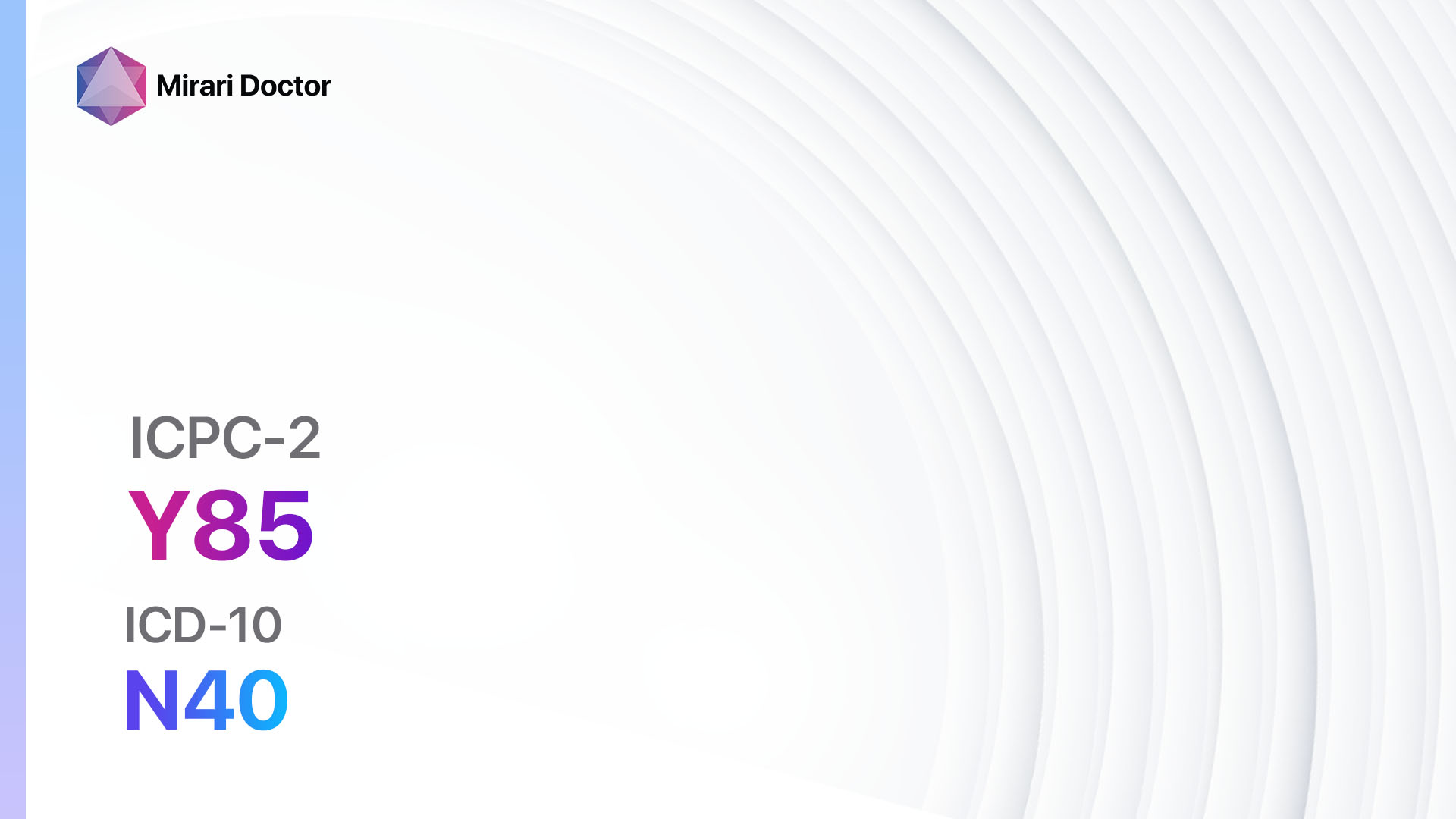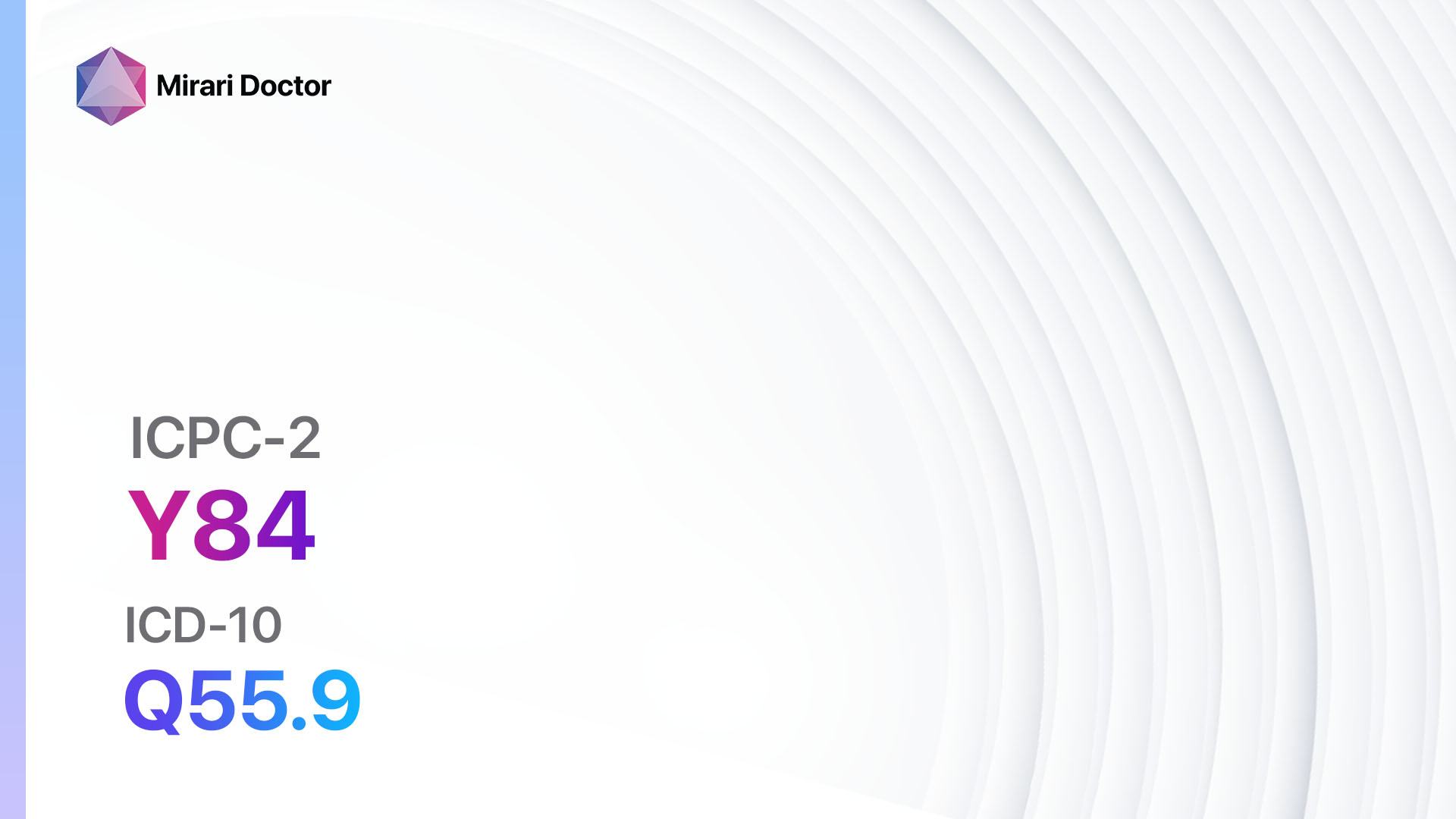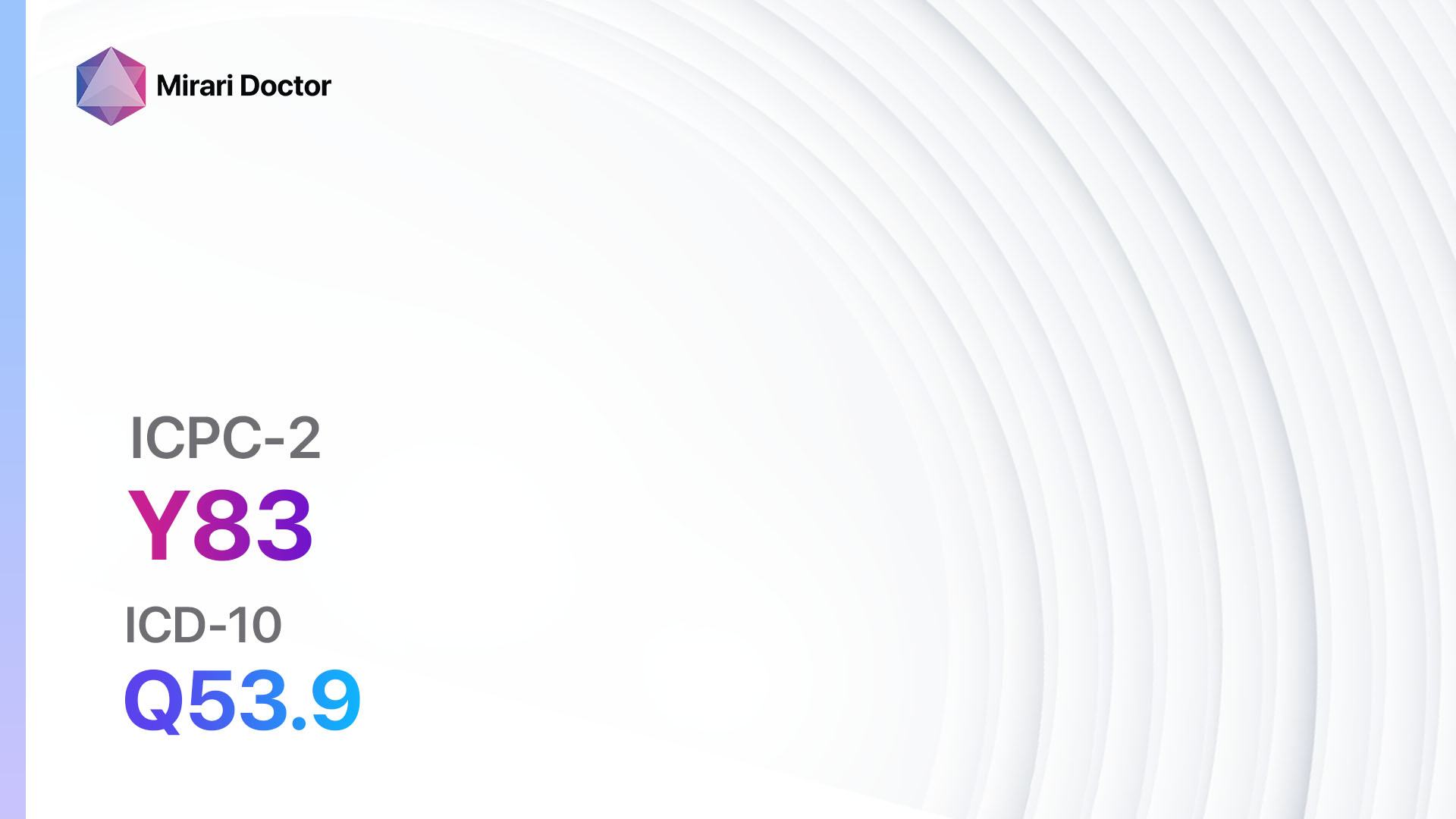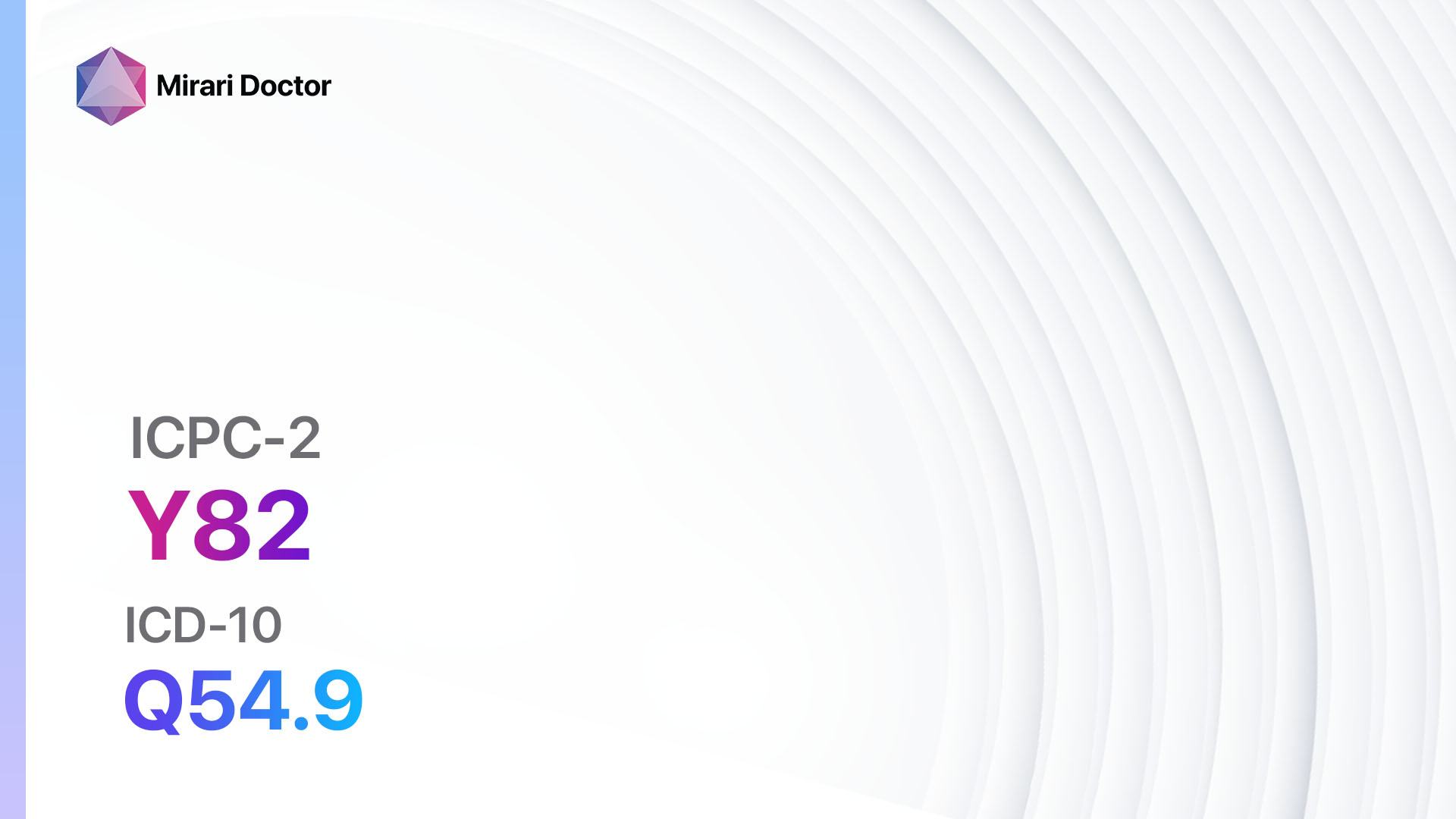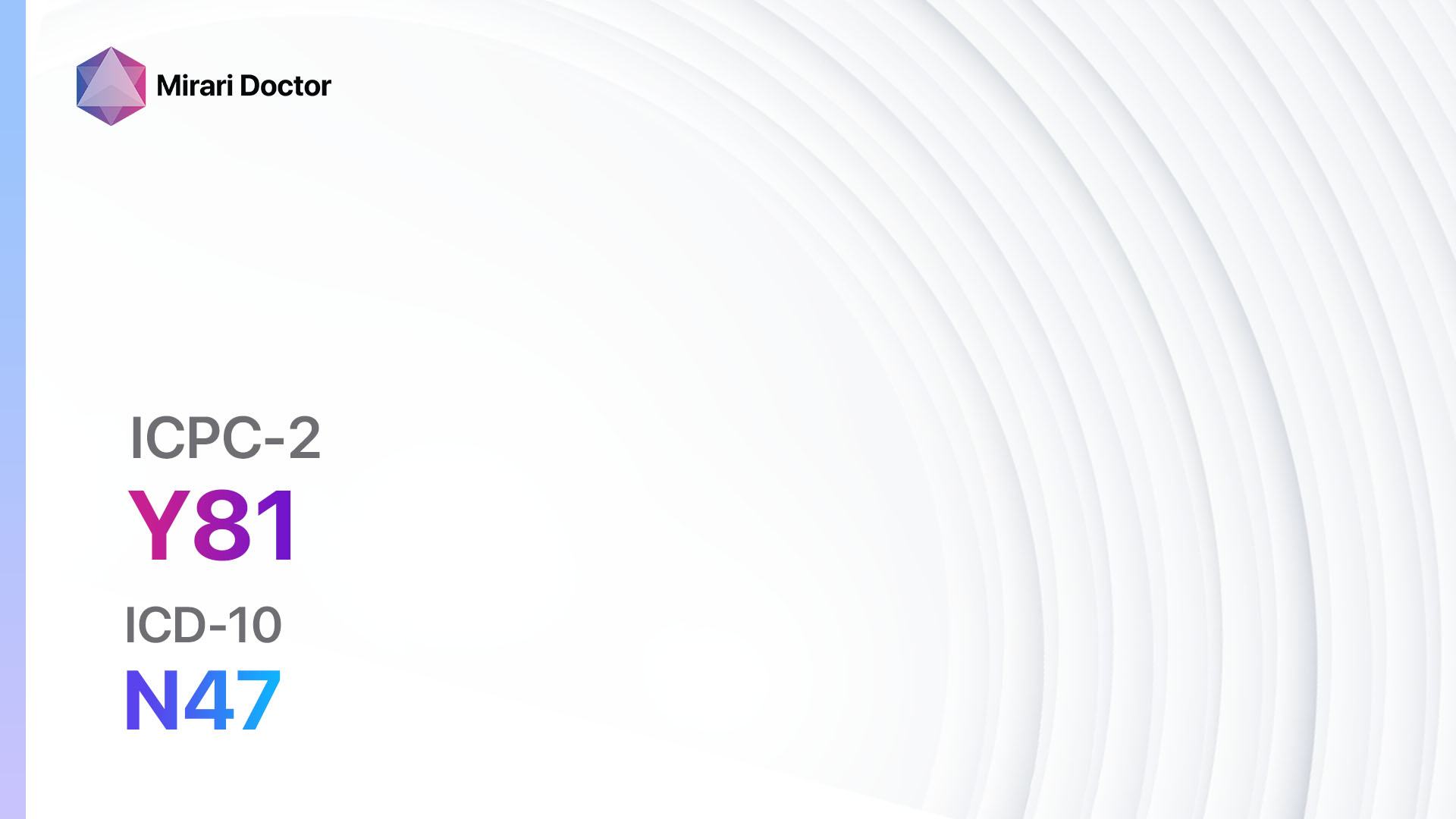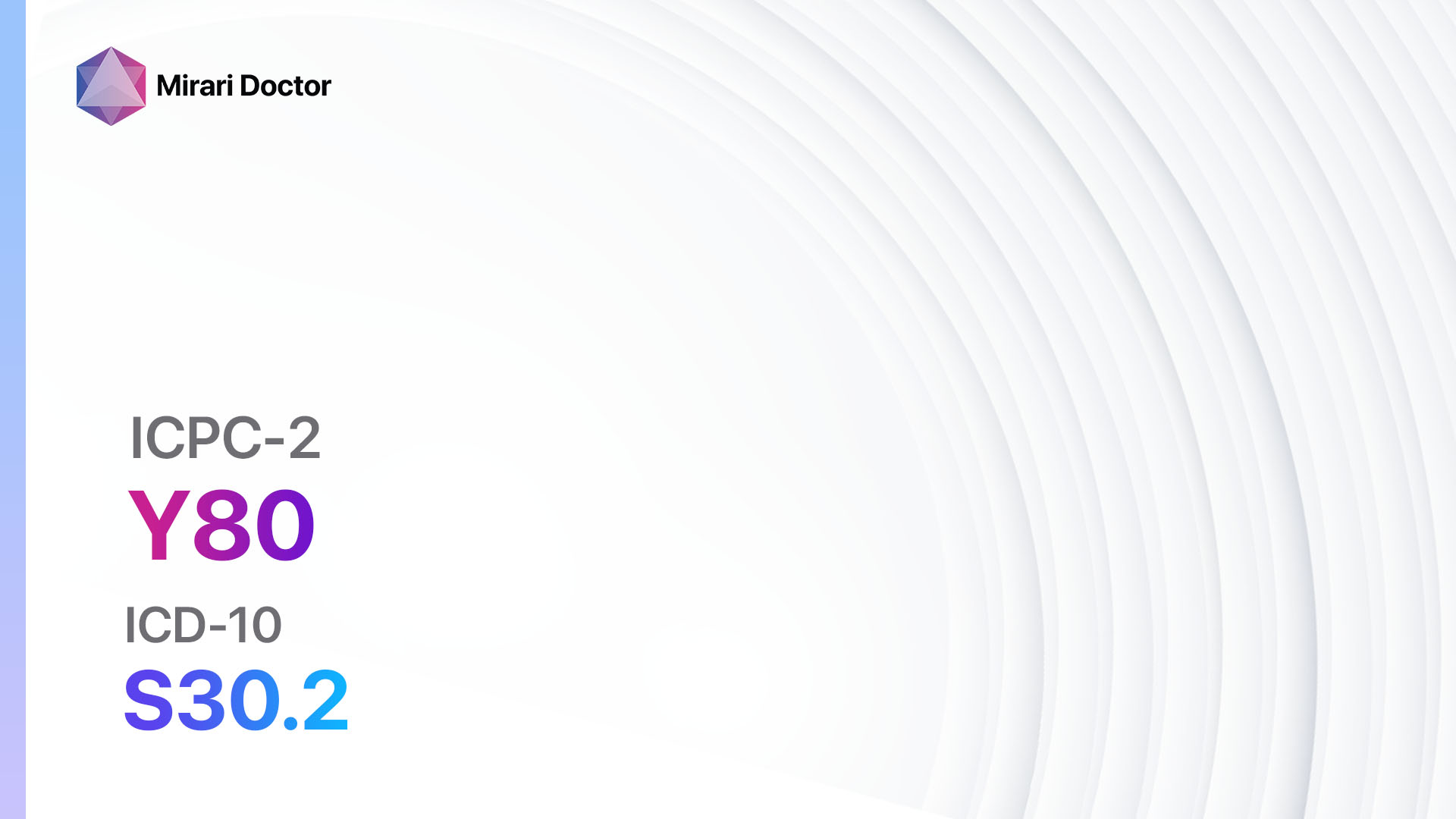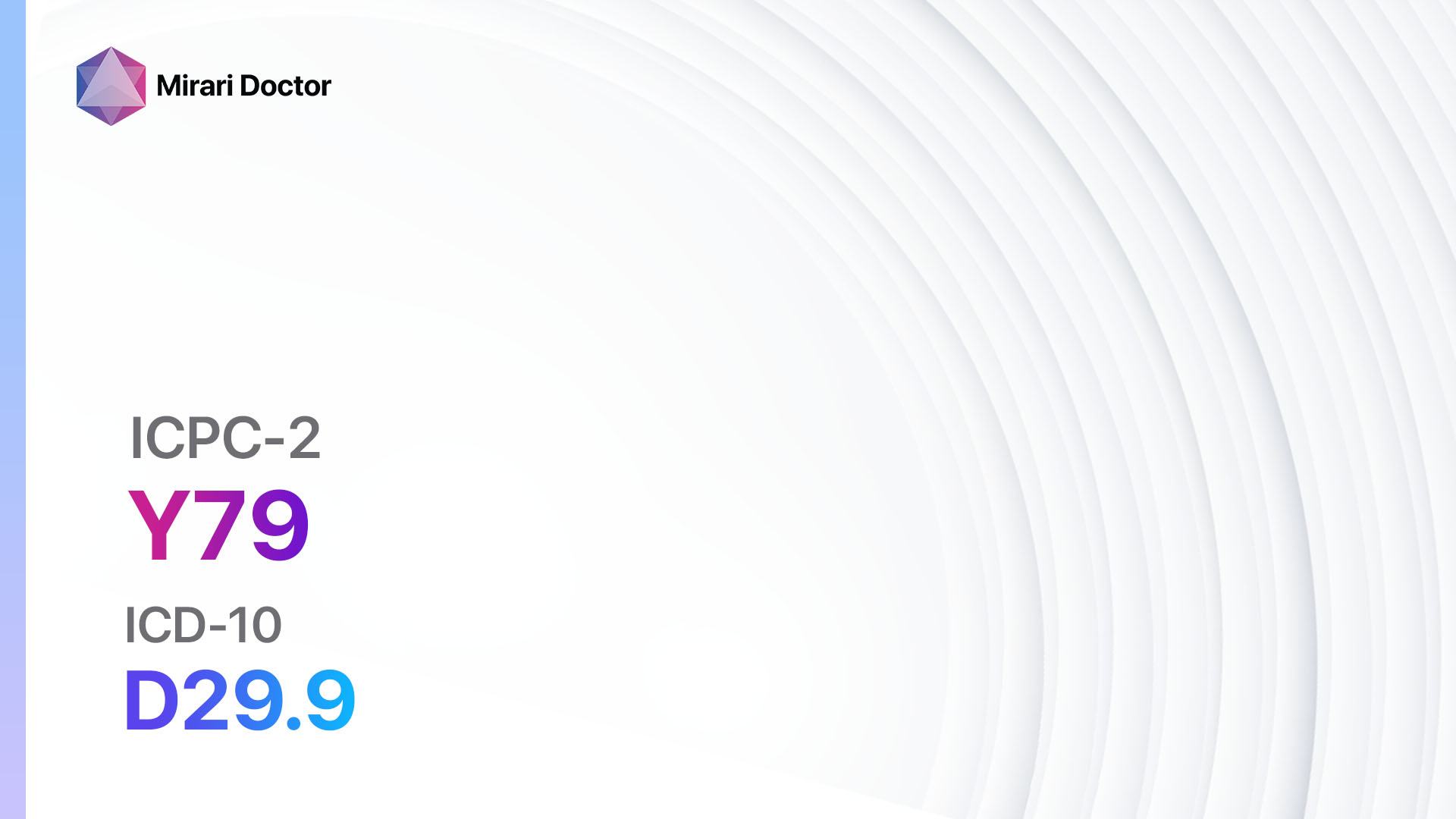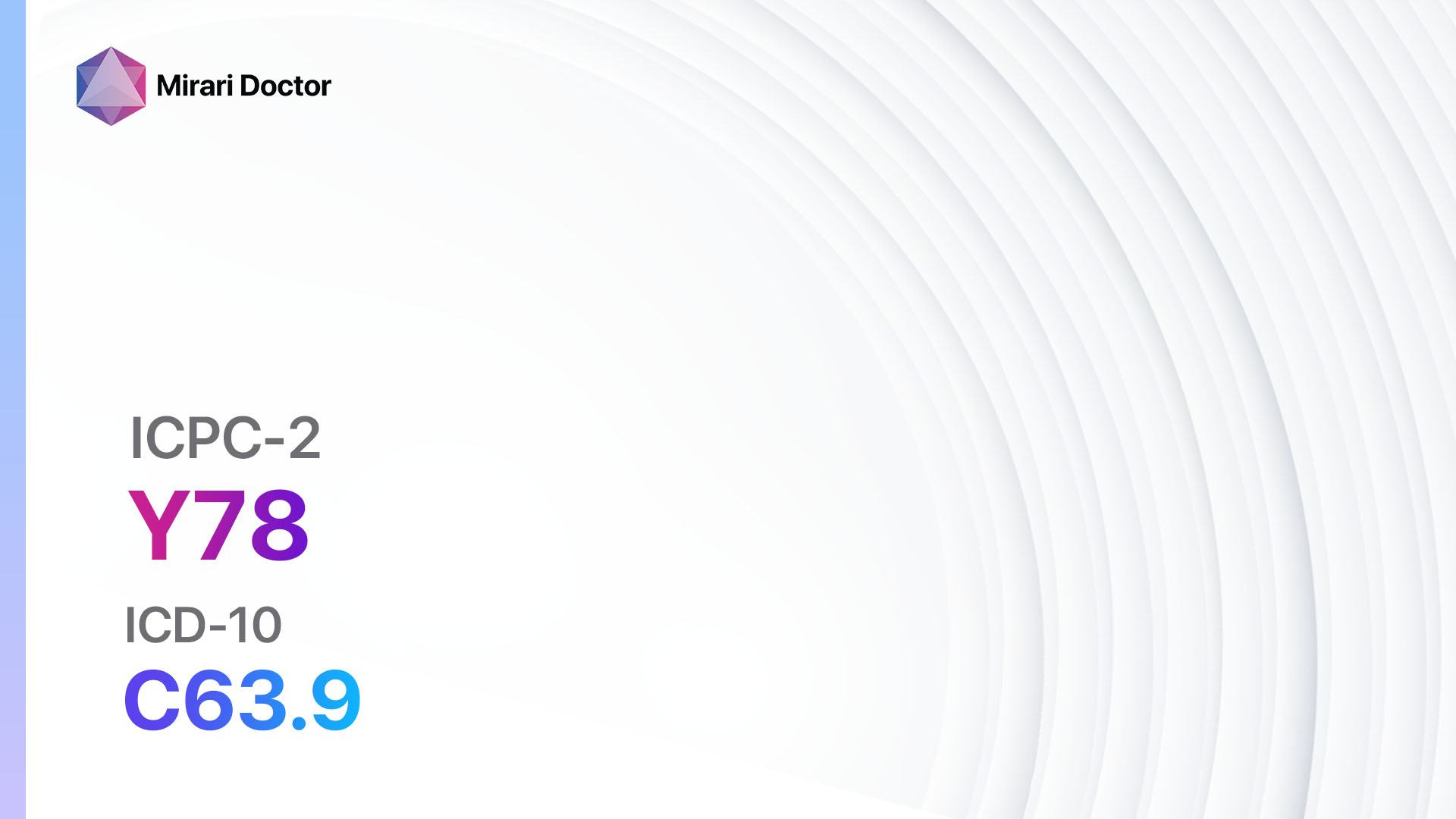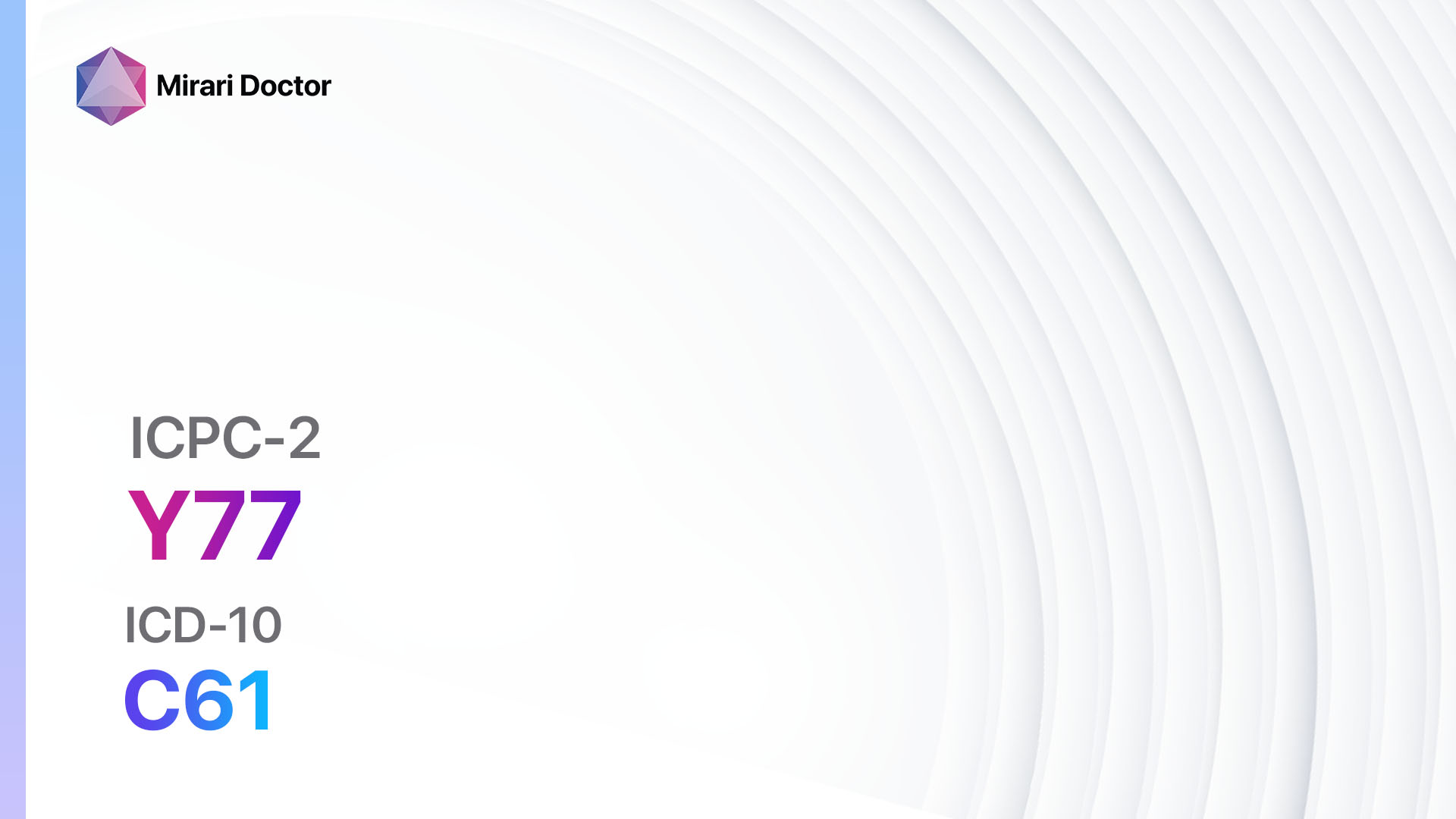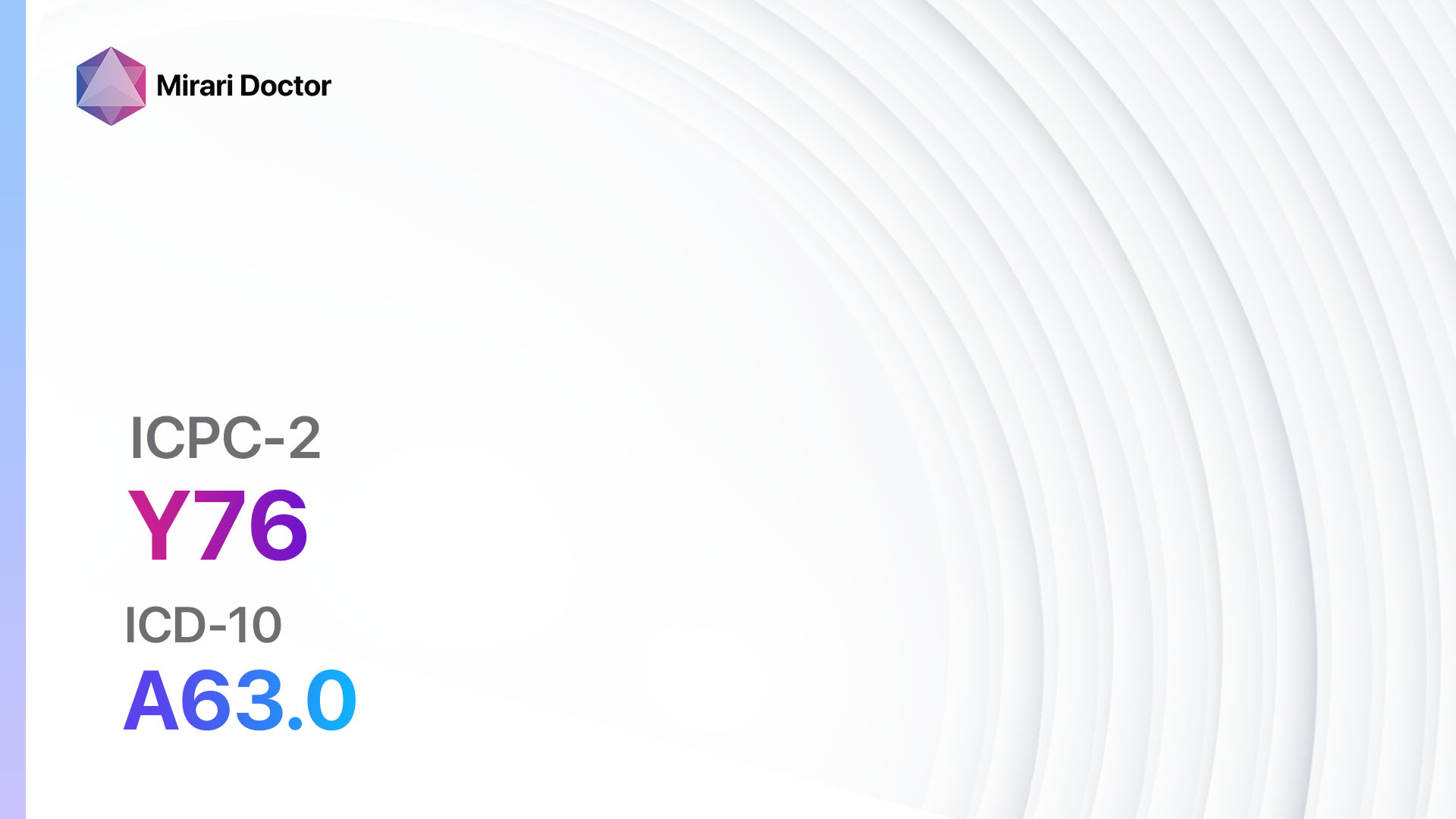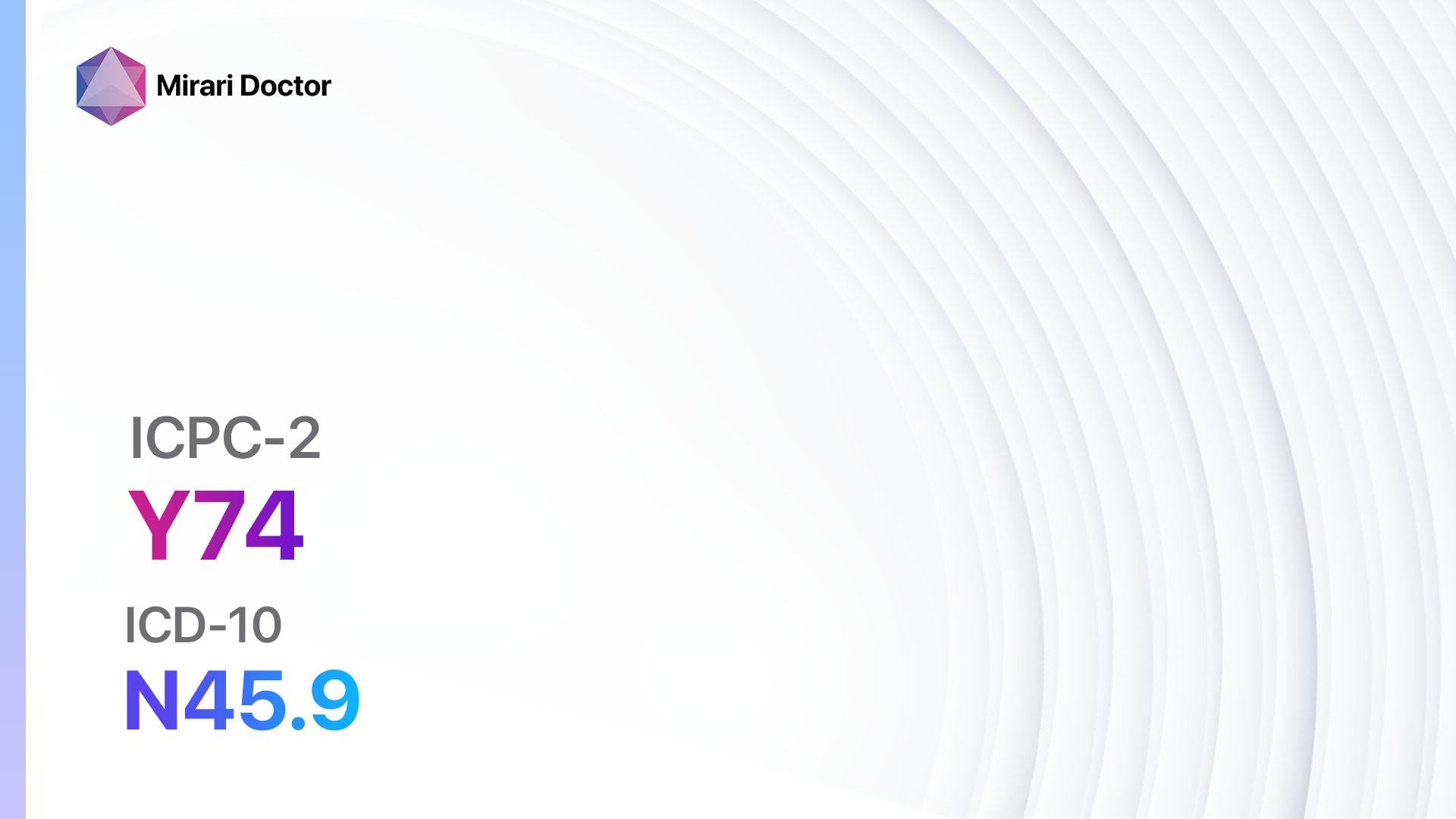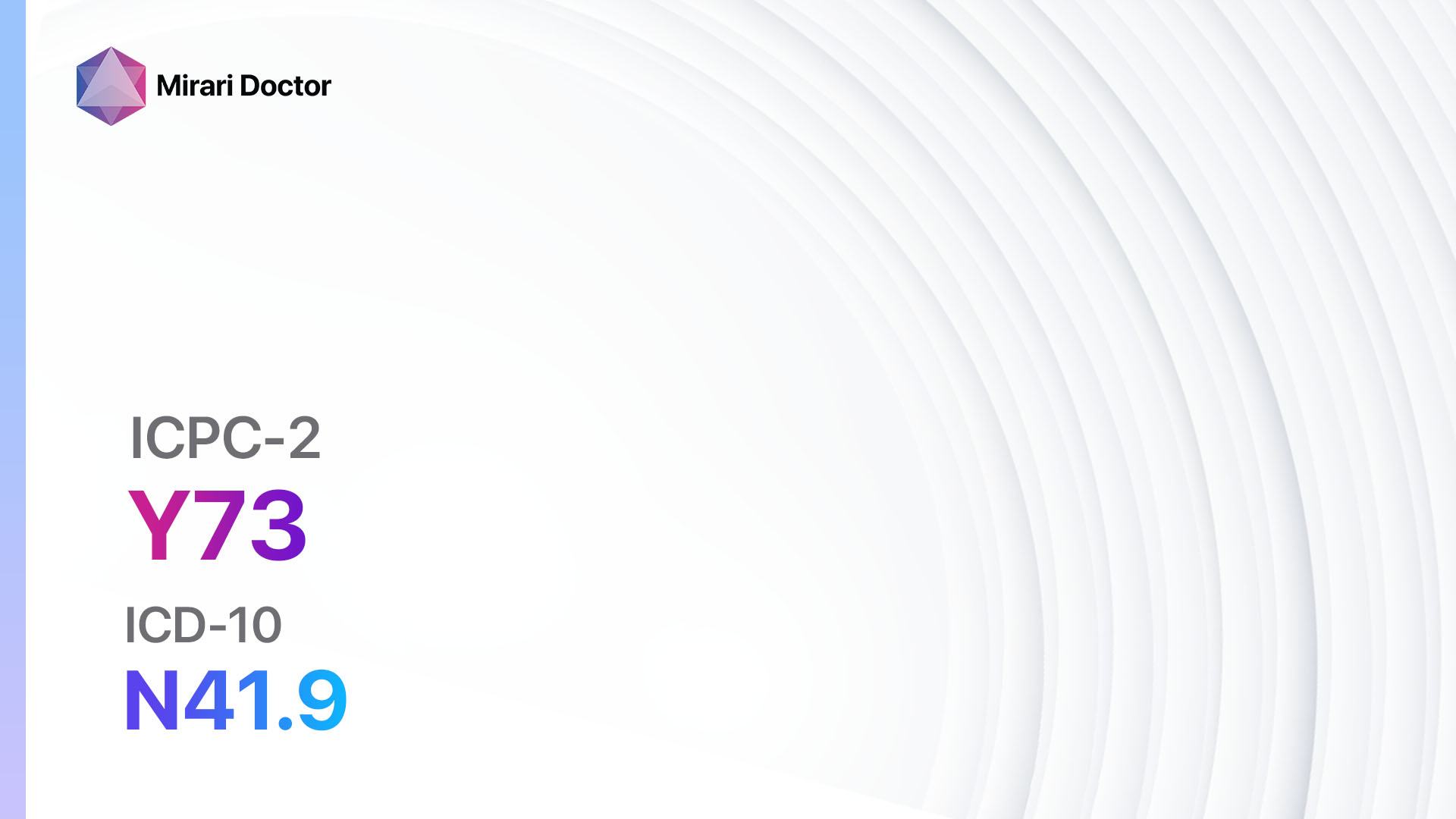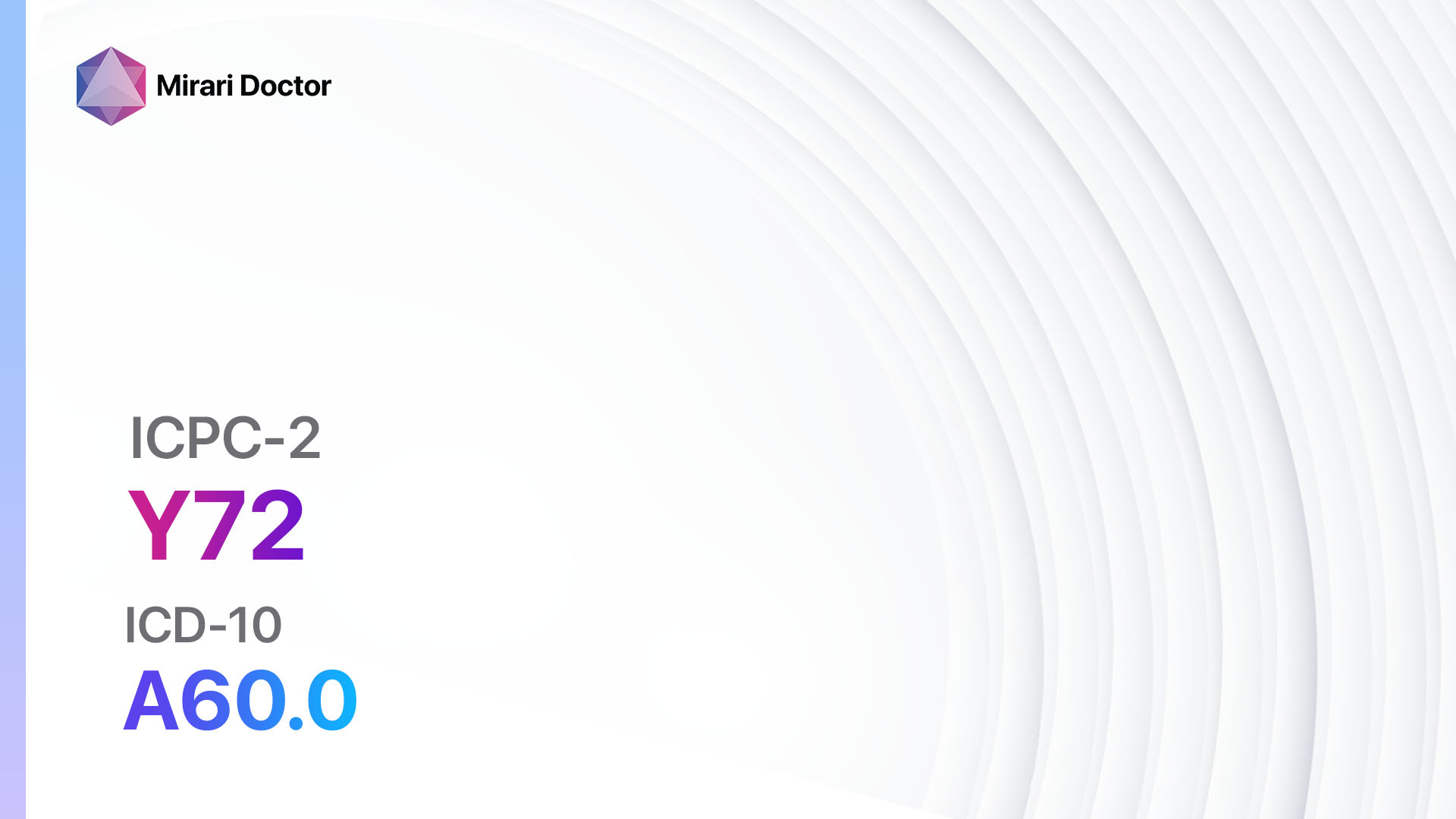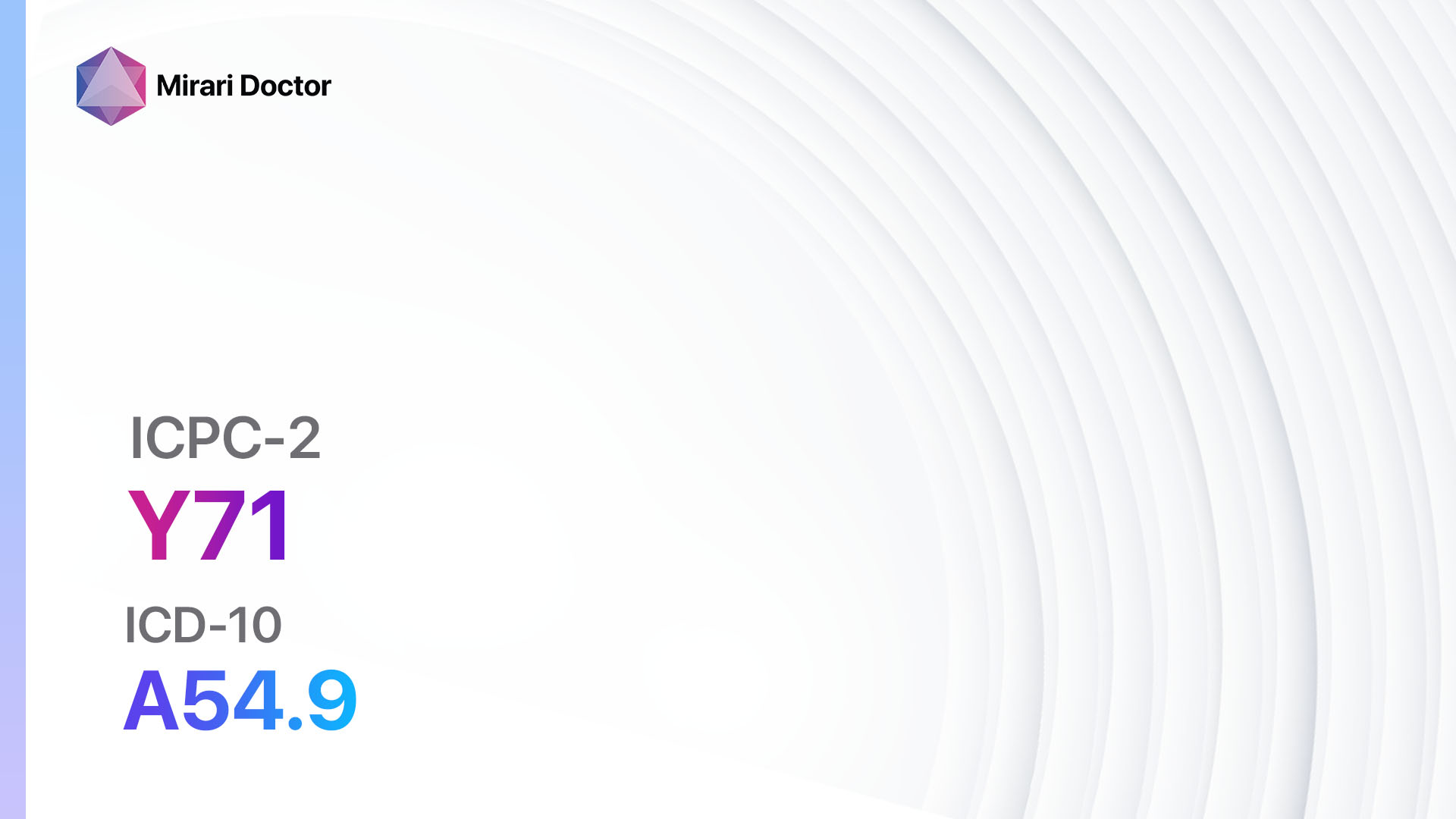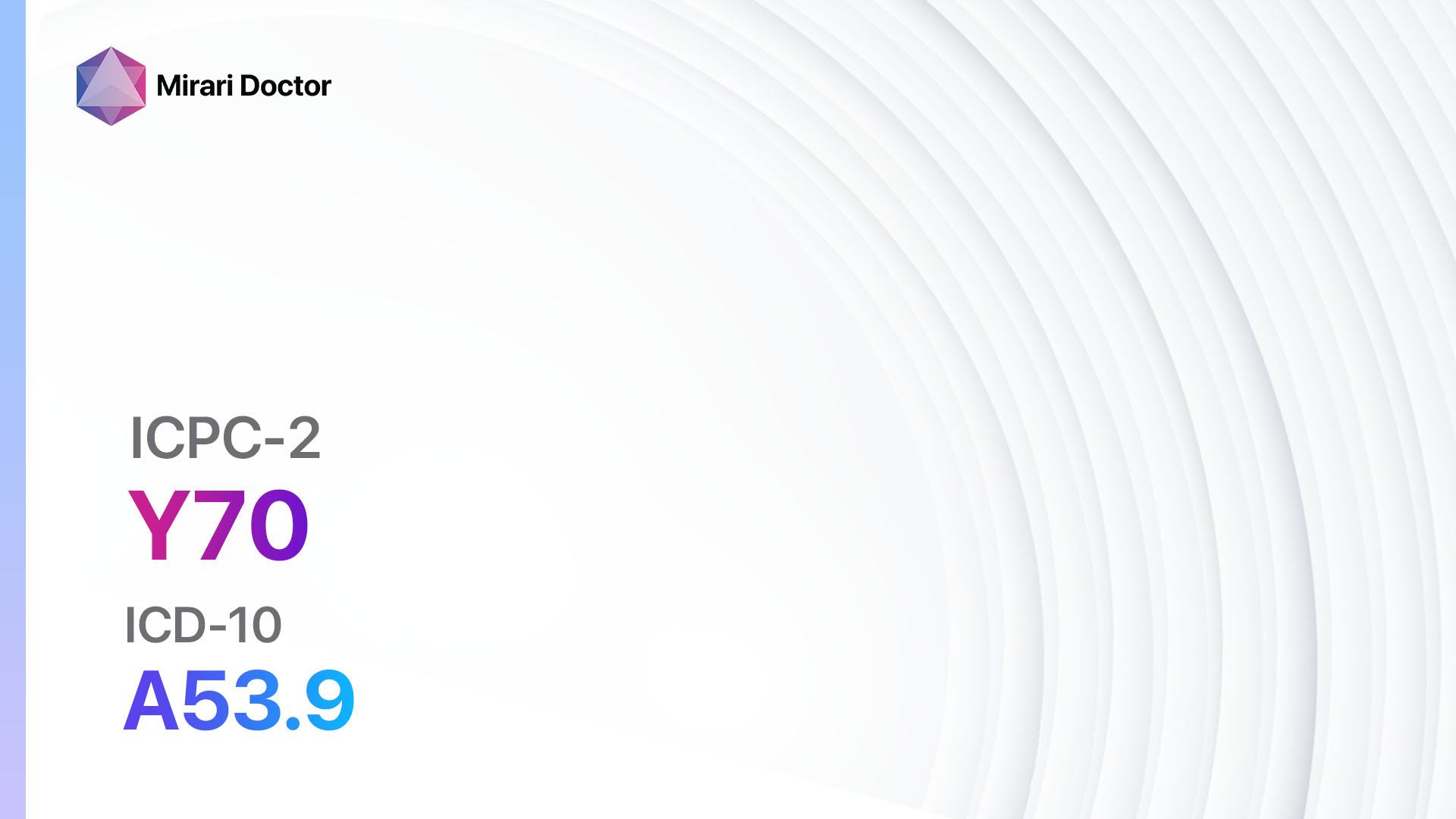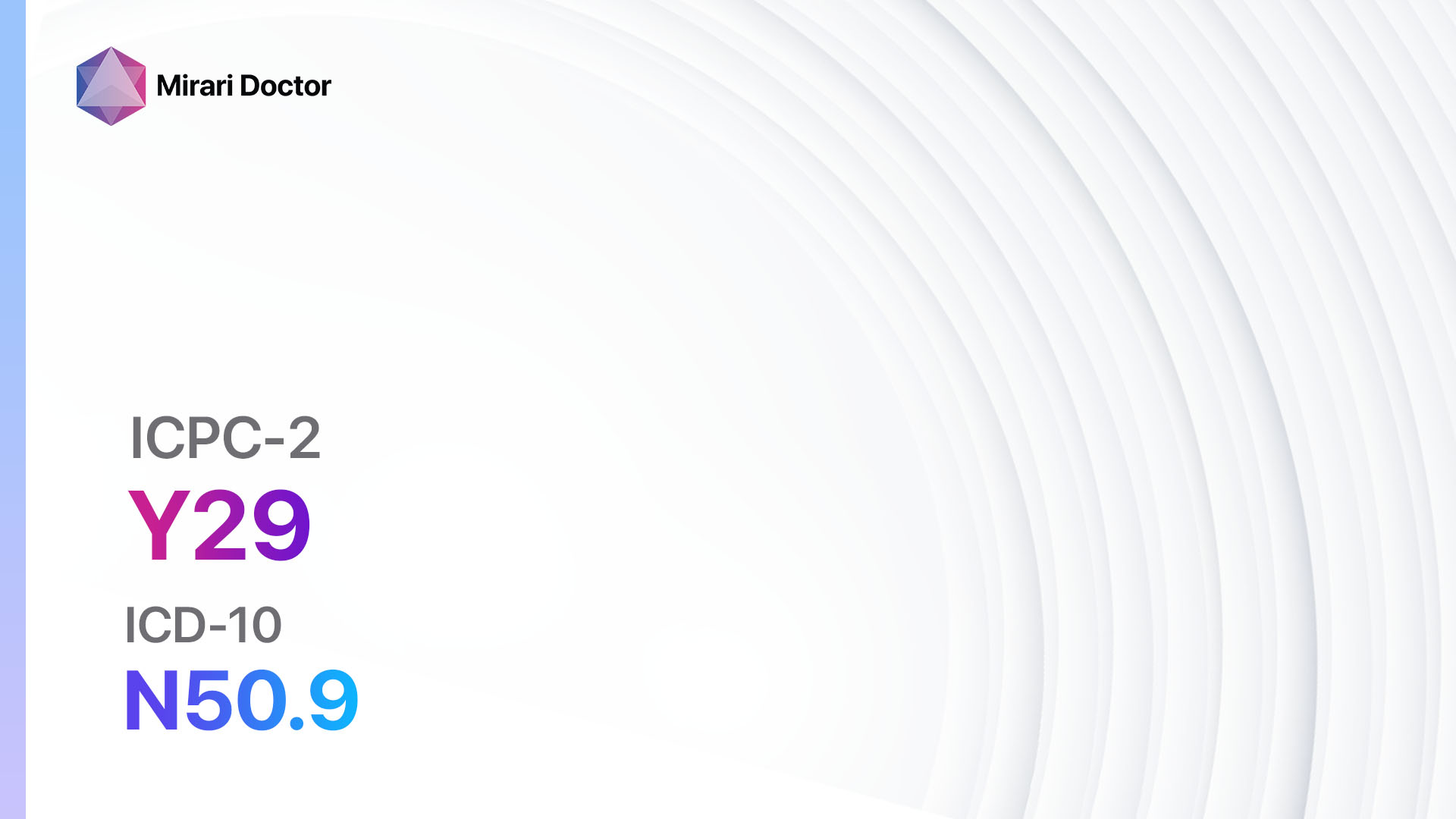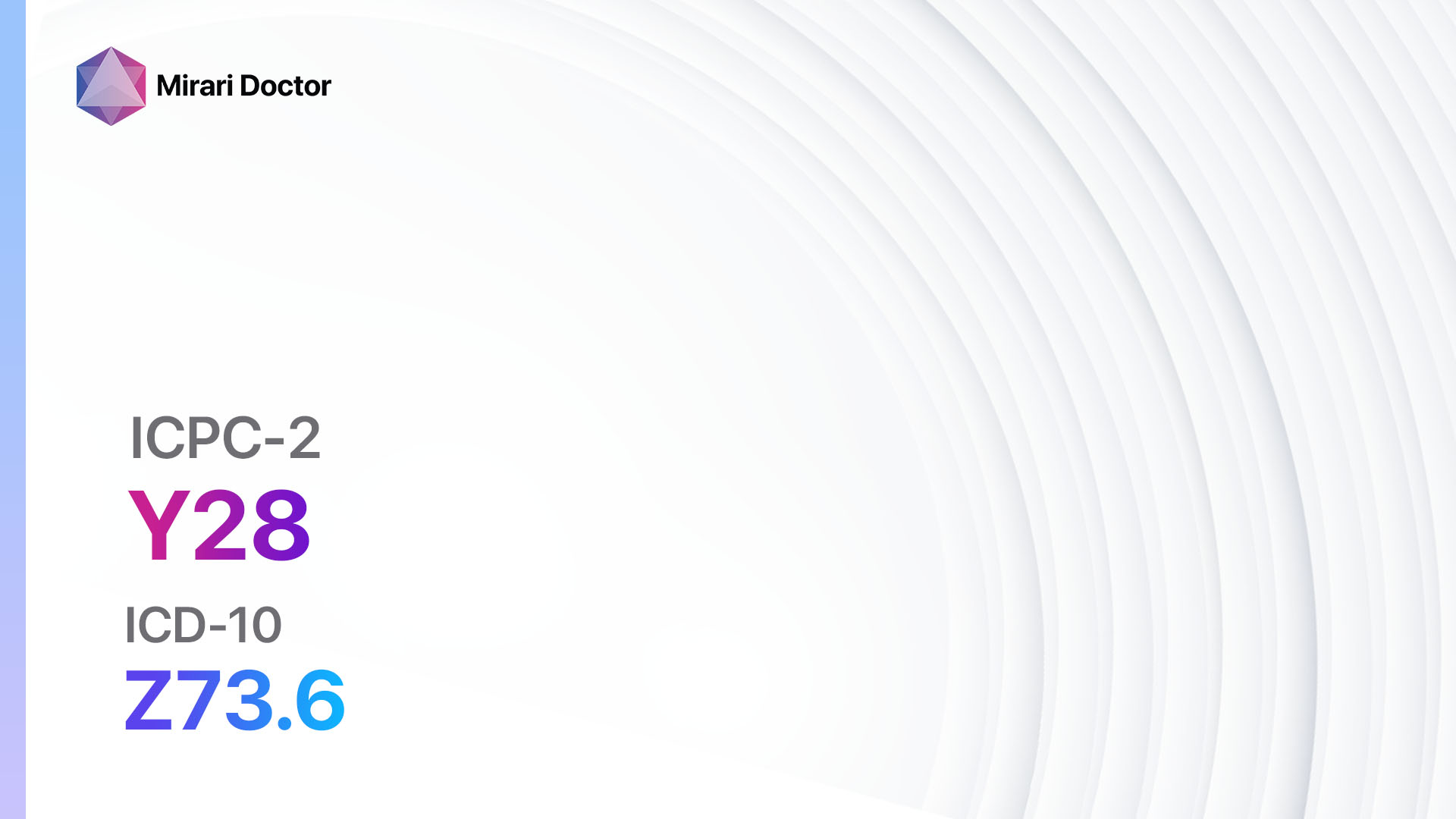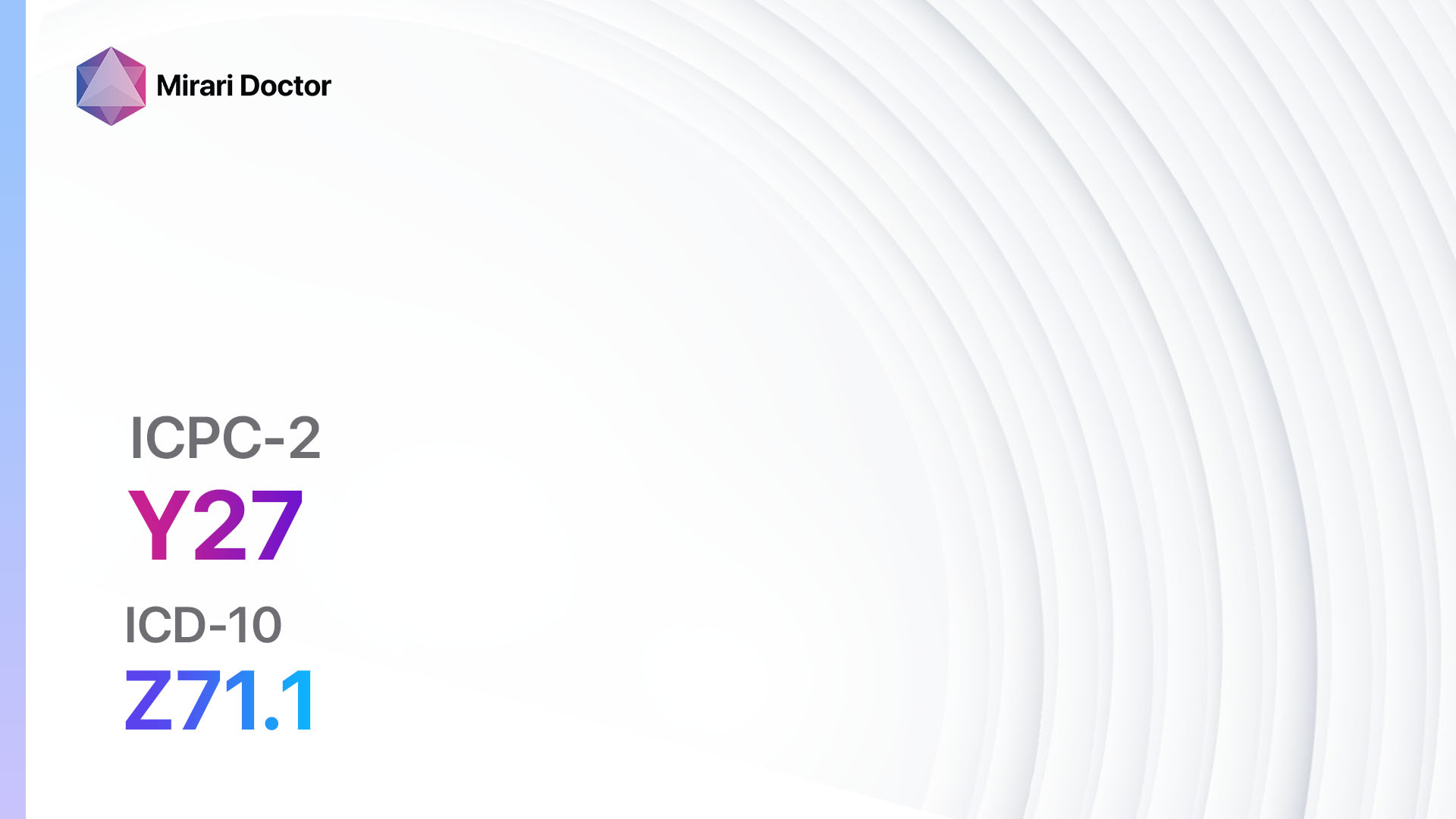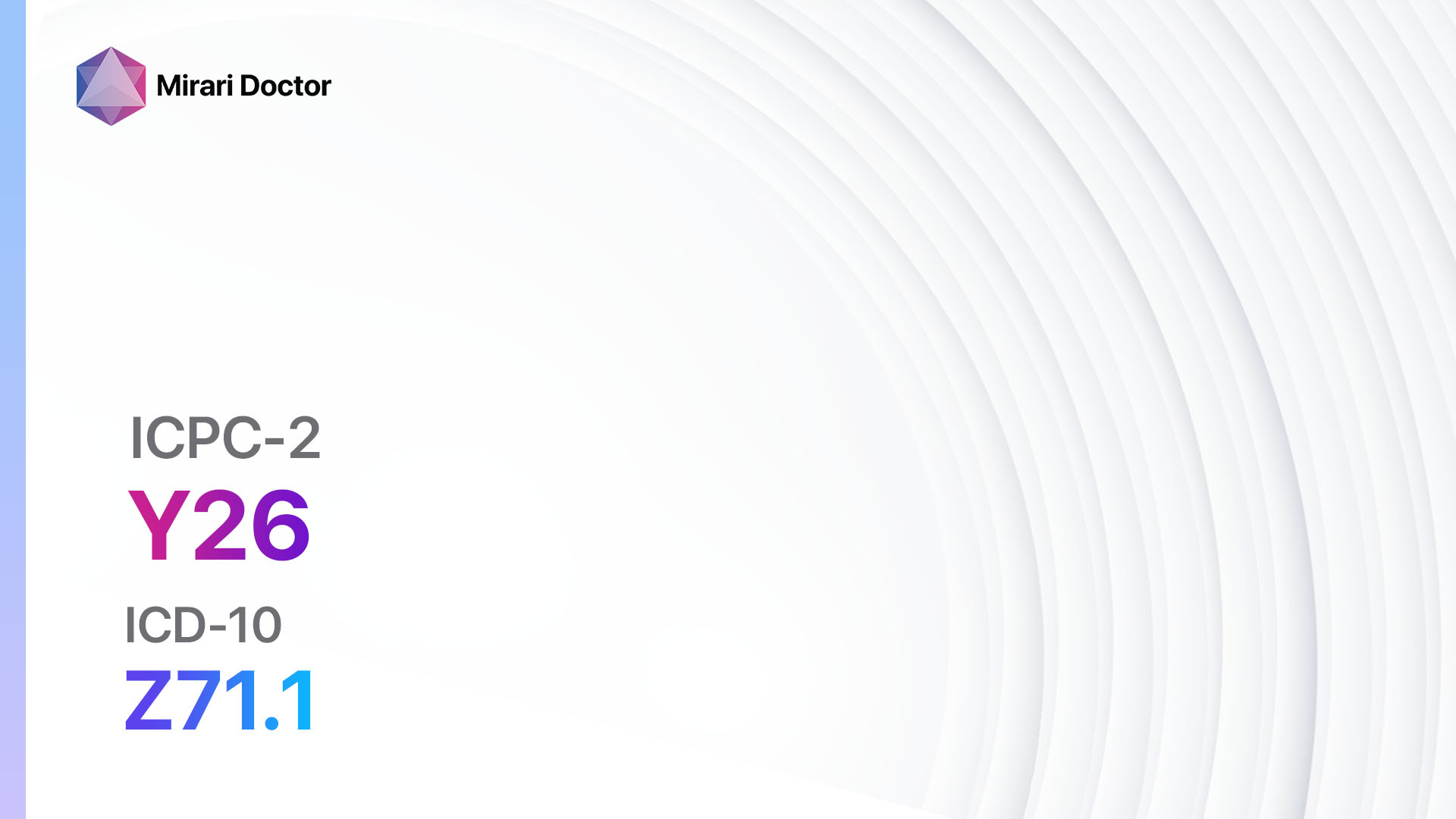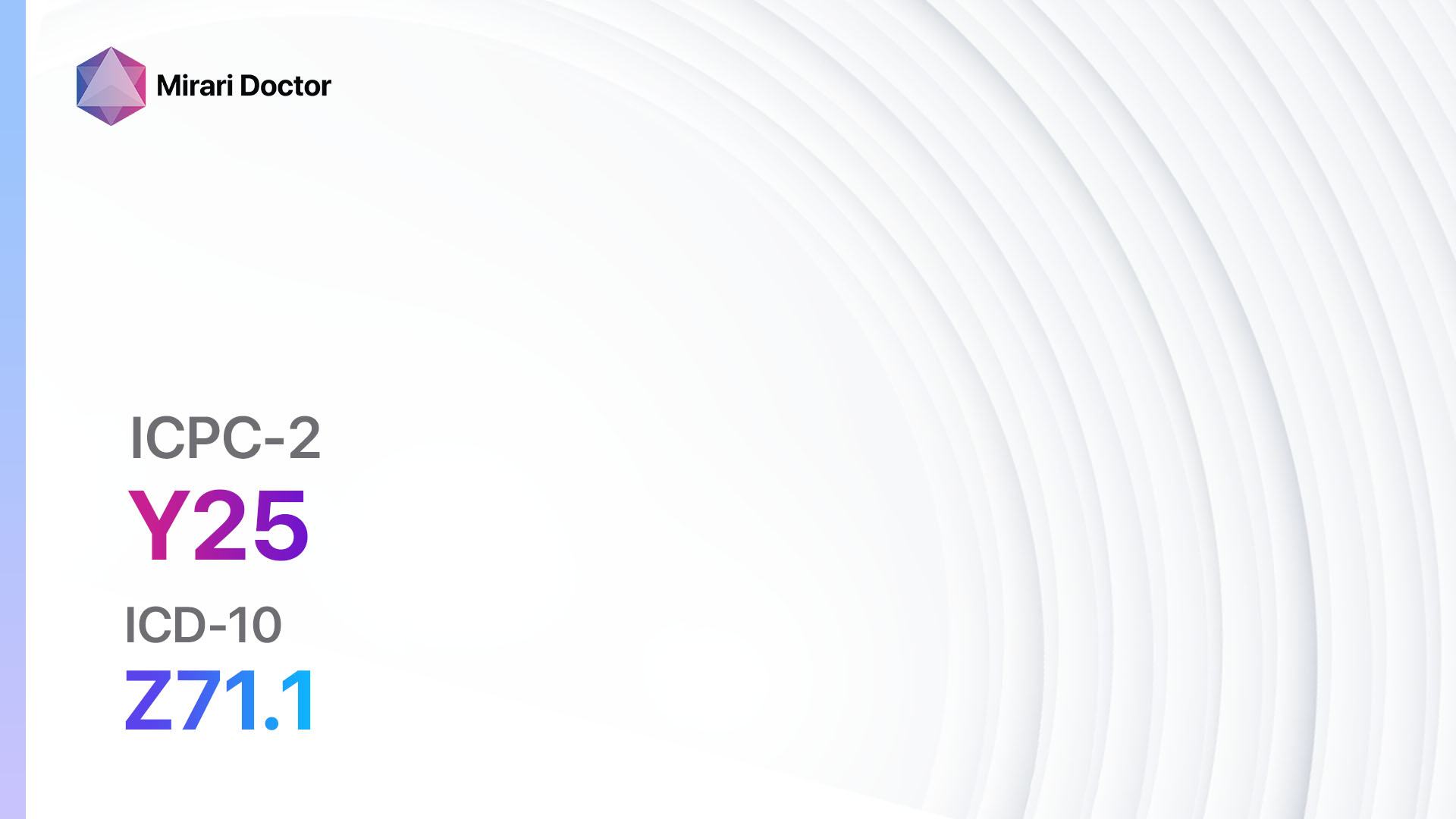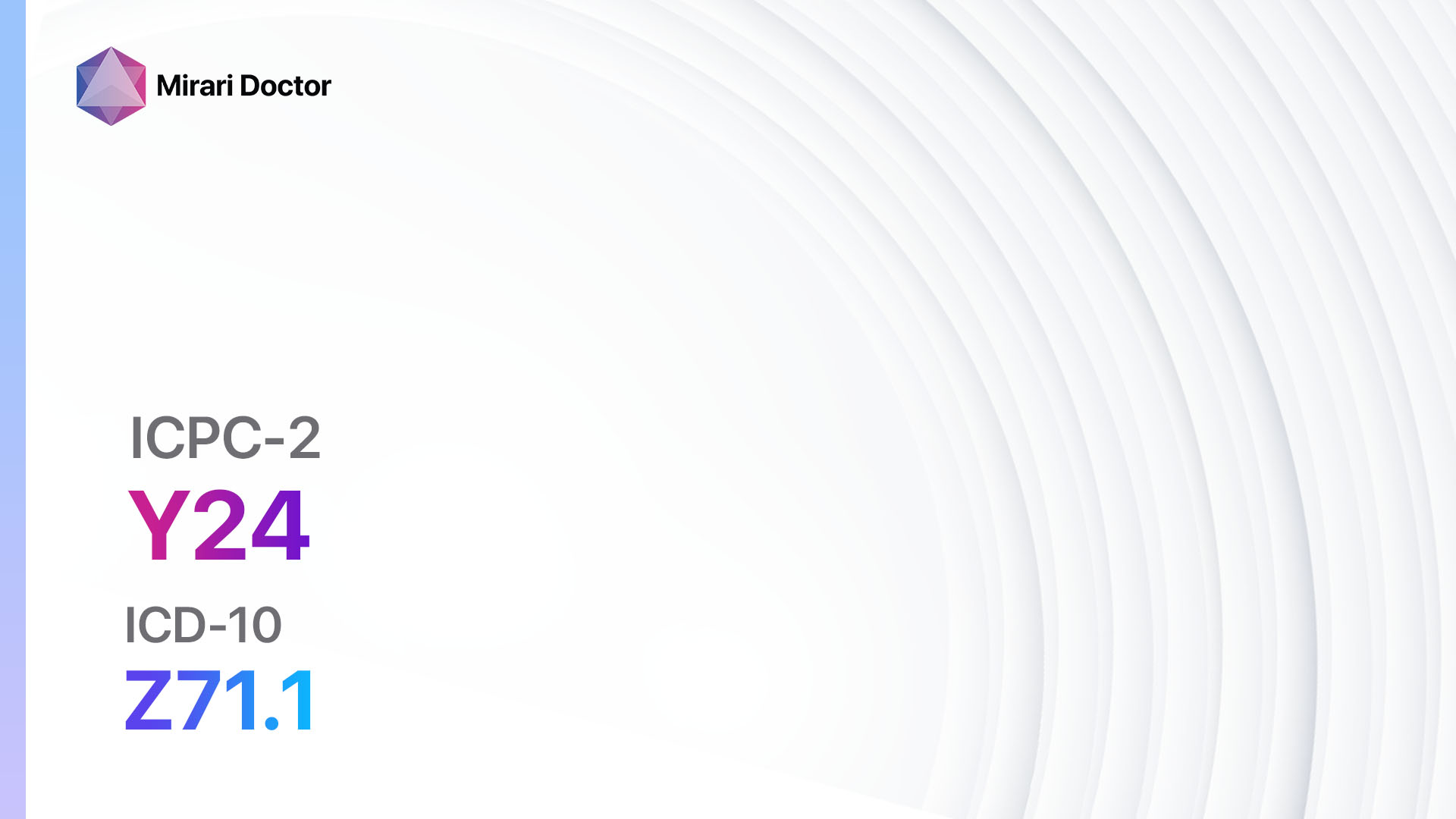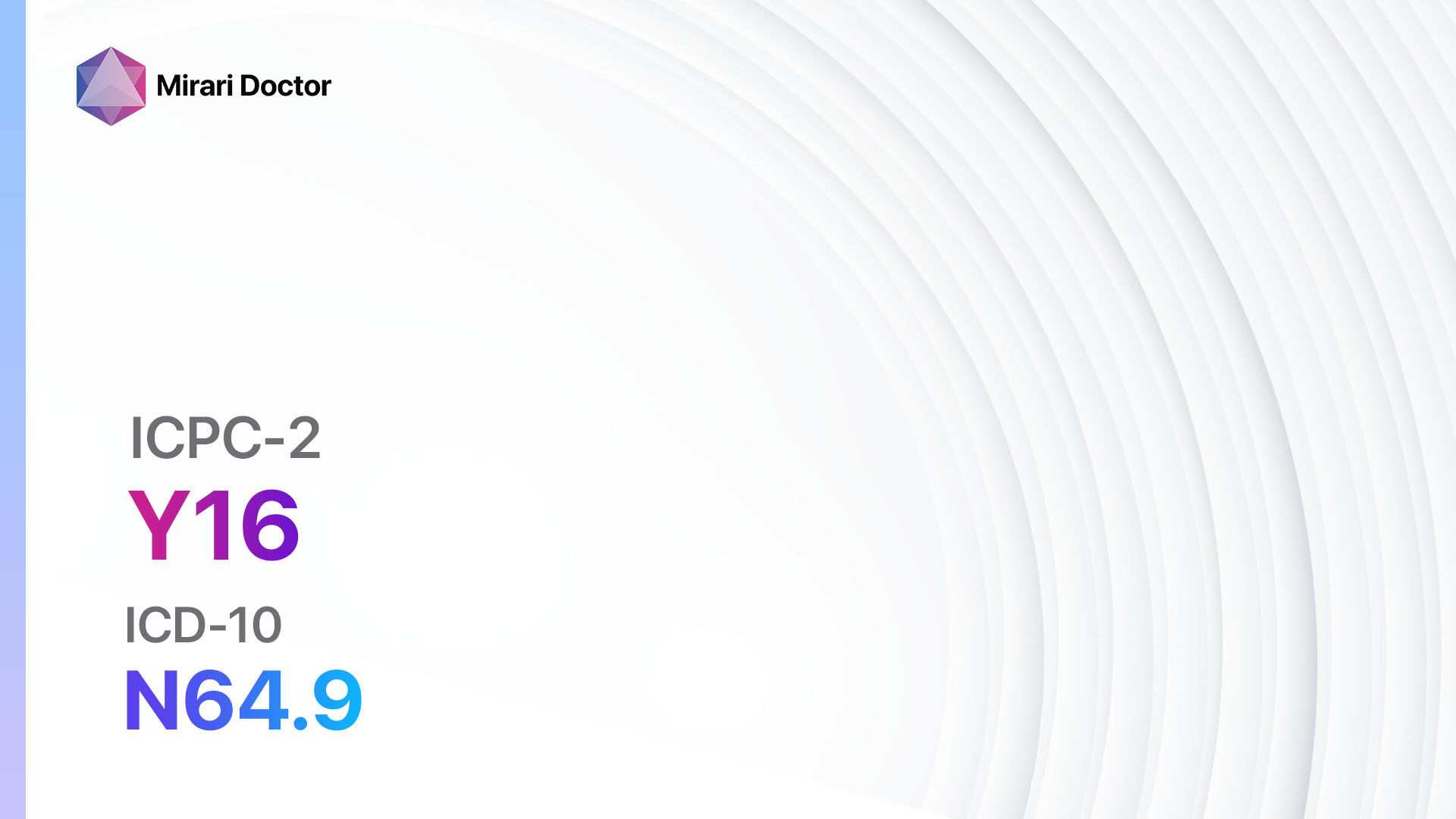
Introduction
Breast symptoms or complaints in males, although rare, can be a cause for concern. It is important to evaluate these symptoms to determine the underlying cause and provide appropriate management[1]. This guide aims to outline the diagnostic steps, possible interventions, and patient education related to breast symptoms/complaints in males.
Codes
- ICPC-2 Code: Y16 Breast symptom/complaint male[2]
- ICD-10 Code: N64.9 Disorder of breast, unspecified[3]
Symptoms
- Breast lump or mass: Presence of a palpable lump or mass in the breast tissue.
- Breast pain or tenderness: Discomfort or sensitivity in the breast area.
- Nipple discharge: Fluid or discharge coming out of the nipple.
- Changes in breast appearance: Swelling, redness, or changes in the shape or size of the breast.
- Enlarged lymph nodes: Presence of enlarged lymph nodes in the armpit area[4].
Causes
- Gynecomastia: Hormonal imbalance leading to benign enlargement of breast tissue.
- Breast infection or abscess: Infection in the breast tissue resulting in swelling, pain, and redness.
- Breast cancer: Rare, but can occur in males and present with similar symptoms as in females.
- Medications: Certain medications can cause breast enlargement or tenderness as a side effect.
- Trauma or injury to the breast area: Injury to the breast tissue can lead to symptoms such as pain or swelling[5].
Diagnostic Steps
Medical History
- Gather information about the patient’s symptoms, including the duration, severity, and any associated factors (e.g., trauma, medication use).
- Review the patient’s medical history, including any previous breast conditions, hormonal disorders, or medications.
- Assess the presence of any risk factors for breast cancer, such as family history, age, or exposure to estrogen-like substances[6].
Physical Examination
- Perform a thorough physical examination of the breast tissue, including inspection, palpation, and assessment of nipple discharge.
- Assess the presence of any abnormalities in the breast tissue, such as lumps, swelling, or changes in skin color or texture.
- Examine the lymph nodes in the armpit area for any enlargement or tenderness[7].
Laboratory Tests
- Blood tests: Evaluate hormone levels, liver function, and other relevant parameters.
- Biopsy: If a breast mass or abnormality is identified, a biopsy may be necessary to determine if it is benign or cancerous[8].
Diagnostic Imaging
- Mammogram: X-ray examination of the breast tissue to detect any abnormalities or masses.
- Ultrasound: Use of sound waves to produce images of the breast tissue and evaluate any lumps or masses.
- MRI (Magnetic Resonance Imaging): Provides detailed images of the breast tissue, especially useful in cases where mammogram or ultrasound results are inconclusive[9].
Other Tests
- Genetic testing: In cases with a strong family history of breast cancer, genetic testing may be recommended to assess the risk.
- Ductography: Injection of contrast dye into the breast ducts to evaluate any abnormalities or blockages.
- Fine needle aspiration or core needle biopsy: In cases of suspicious breast masses, a sample may be collected for further analysis[10].
Follow-up and Patient Education
- Provide the patient with a clear diagnosis and explanation of the underlying cause of their symptoms.
- Discuss the treatment options and possible interventions based on the specific diagnosis.
- Emphasize the importance of regular follow-up appointments and monitoring for any changes or new symptoms.
- Provide education on self-breast examination and encourage the patient to report any concerns or changes in their symptoms.
Possible Interventions
Traditional Interventions
Medications:
Top 5 drugs for breast symptoms/complaints in males:
- Tamoxifen:
- Cost: $10-$100/month
- Contraindications: History of blood clots, pregnancy, or breastfeeding.
- Side effects: Hot flashes, nausea, fatigue.
- Severe side effects: Increased risk of uterine cancer, blood clots.
- Drug interactions: Anticoagulants, selective serotonin reuptake inhibitors (SSRIs).
- Warning: Regular monitoring of liver function and blood cell counts is required.
- Anastrozole:
- Cost: $100-$500/month
- Contraindications: Severe liver disease, pregnancy, or breastfeeding.
- Side effects: Joint pain, hot flashes, fatigue.
- Severe side effects: Osteoporosis, increased risk of heart disease.
- Drug interactions: Estrogen-containing medications, tamoxifen.
- Warning: Regular monitoring of bone density and lipid levels is required.
- Letrozole:
- Cost: $100-$500/month
- Contraindications: Severe liver disease, pregnancy, or breastfeeding.
- Side effects: Joint pain, hot flashes, fatigue.
- Severe side effects: Osteoporosis, increased risk of heart disease.
- Drug interactions: Estrogen-containing medications, tamoxifen.
- Warning: Regular monitoring of bone density and lipid levels is required.
- Danazol:
- Cost: $100-$500/month
- Contraindications: Severe liver disease, pregnancy, or breastfeeding.
- Side effects: Weight gain, acne, voice changes.
- Severe side effects: Liver tumors, increased risk of blood clots.
- Drug interactions: Anticoagulants, cyclosporine.
- Warning: Regular monitoring of liver function and blood cell counts is required.
- Testosterone replacement therapy:
- Cost: $100-$500/month
- Contraindications: Prostate cancer, breast cancer, severe heart disease.
- Side effects: Acne, fluid retention, mood changes.
- Severe side effects: Increased risk of blood clots, prostate enlargement.
- Drug interactions: Anticoagulants, insulin.
- Warning: Regular monitoring of prostate-specific antigen (PSA) levels is required.
Alternative Drugs:
- Dydrogesterone: Progesterone derivative used for hormonal imbalance.
- Bromocriptine: Dopamine agonist used for the treatment of gynecomastia.
- Octreotide: Somatostatin analog used for the treatment of hormone-secreting tumors.
Surgical Procedures:
- Mastectomy: Surgical removal of the breast tissue, usually performed in cases of breast cancer or severe gynecomastia. Cost: $5,000-$20,000.
- Excisional biopsy: Surgical removal of a breast lump or mass for further analysis. Cost: $3,000-$10,000.
Alternative Interventions
- Acupuncture: May help alleviate breast pain and discomfort. Cost: $60-$120 per session.
- Herbal remedies: Certain herbs like sage, turmeric, and evening primrose oil may have potential benefits in managing breast symptoms. Cost: Varies depending on the specific supplement.
- Meditation and relaxation techniques: Can help reduce stress and improve overall well-being. Cost: Free to minimal cost.
- Physical therapy: May help alleviate breast pain or discomfort through targeted exercises and techniques. Cost: $50-$150 per session.
- Support groups and counseling: Provide emotional support and coping strategies for individuals experiencing breast symptoms. Cost: Varies depending on the specific program or counselor.
Lifestyle Interventions
- Healthy diet: Encourage a balanced diet rich in fruits, vegetables, whole grains, and lean proteins. Cost: Varies depending on individual food choices.
- Regular exercise: Promote regular physical activity, such as brisk walking or jogging, to improve overall health and well-being. Cost: Free to minimal cost.
- Stress management: Encourage stress-reducing activities like yoga, mindfulness meditation, or deep breathing exercises. Cost: Free to minimal cost.
- Avoidance of estrogen-like substances: Educate patients on avoiding exposure to substances that mimic estrogen, such as certain plastics or pesticides. Cost: Free.
It is important to note that the cost ranges provided are approximate and may vary depending on the location and availability of the interventions. It is recommended to consult with healthcare professionals for personalized treatment options and cost estimates.
Mirari Cold Plasma Alternative Intervention
Understanding Mirari Cold Plasma
- Safe and Non-Invasive Treatment: Mirari Cold Plasma is a safe and non-invasive treatment option for various skin conditions. It does not require incisions, minimizing the risk of scarring, bleeding, or tissue damage.
- Efficient Extraction of Foreign Bodies: Mirari Cold Plasma facilitates the removal of foreign bodies from the skin by degrading and dissociating organic matter, allowing easier access and extraction.
- Pain Reduction and Comfort: Mirari Cold Plasma has a local analgesic effect, providing pain relief during the treatment, making it more comfortable for the patient.
- Reduced Risk of Infection: Mirari Cold Plasma has antimicrobial properties, effectively killing bacteria and reducing the risk of infection.
- Accelerated Healing and Minimal Scarring: Mirari Cold Plasma stimulates wound healing and tissue regeneration, reducing healing time and minimizing the formation of scars.
Mirari Cold Plasma Prescription
Video instructions for using Mirari Cold Plasma Device – Y16 Breast symptom/complaint male (ICD-10:N64.9)
| Mild | Moderate | Severe |
| Mode setting: 1 (Infection) Location: 0 (Localized) Morning: 15 minutes, Evening: 15 minutes |
Mode setting: 1 (Infection) Location: 0 (Localized) Morning: 30 minutes, Lunch: 30 minutes, Evening: 30 minutes |
Mode setting: 1 (Infection) Location: 0 (Localized) Morning: 30 minutes, Lunch: 30 minutes, Evening: 30 minutes |
| Mode setting: 2 (Wound Healing) Location: 0 (Localized) Morning: 15 minutes, Evening: 15 minutes |
Mode setting: 2 (Wound Healing) Location: 0 (Localized) Morning: 30 minutes, Lunch: 30 minutes, Evening: 30 minutes |
Mode setting: 2 (Wound Healing) Location: 0 (Localized) Morning: 30 minutes, Lunch: 30 minutes, Evening: 30 minutes |
| Mode setting: 5 (Prostatitis Therapy) Location: 2 (Prostate & Uterus) Morning: 15 minutes, Evening: 15 minutes |
Mode setting: 5 (Prostatitis Therapy) Location: 2 (Prostate & Uterus) Morning: 30 minutes, Lunch: 30 minutes, Evening: 30 minutes |
Mode setting: 5 (Prostatitis Therapy) Location: 2 (Prostate & Uterus) Morning: 30 minutes, Lunch: 30 minutes, Evening: 30 minutes |
| Mode setting: 7 (Immunotherapy) Location: 1 (Sacrum) Morning: 15 minutes, Evening: 15 minutes |
Mode setting: 7 (Immunotherapy) Location: 1 (Sacrum) Morning: 30 minutes, Lunch: 30 minutes, Evening: 30 minutes |
Mode setting: 7 (Immunotherapy) Location: 1 (Sacrum) Morning: 30 minutes, Lunch: 30 minutes, Evening: 30 minutes |
| Total Morning: 60 minutes approx. $10 USD, Evening: 60 minutes approx. $10 USD |
Total Morning: 120 minutes approx. $20 USD, Lunch: 120 minutes approx. $20 USD, Evening: 120 minutes approx. $20 USD, |
Total Morning: 120 minutes approx. $20 USD, Lunch: 120 minutes approx. $20 USD, Evening: 120 minutes approx. $20 USD, |
| Usual treatment for 7-60 days approx. $140 USD – $1200 USD | Usual treatment for 6-8 weeks approx. $2,520 USD – $3,360 USD |
Usual treatment for 3-6 months approx. $5,400 USD – $10,800 USD
|
 |
|
Use the Mirari Cold Plasma device to treat Breast symptom/complaint male effectively.
WARNING: MIRARI COLD PLASMA IS DESIGNED FOR THE HUMAN BODY WITHOUT ANY ARTIFICIAL OR THIRD PARTY PRODUCTS. USE OF OTHER PRODUCTS IN COMBINATION WITH MIRARI COLD PLASMA MAY CAUSE UNPREDICTABLE EFFECTS, HARM OR INJURY. PLEASE CONSULT A MEDICAL PROFESSIONAL BEFORE COMBINING ANY OTHER PRODUCTS WITH USE OF MIRARI.
Step 1: Cleanse the Skin
- Start by cleaning the affected area of the skin with a gentle cleanser or mild soap and water. Gently pat the area dry with a clean towel.
Step 2: Prepare the Mirari Cold Plasma device
- Ensure that the Mirari Cold Plasma device is fully charged or has fresh batteries as per the manufacturer’s instructions. Make sure the device is clean and in good working condition.
- Switch on the Mirari device using the power button or by following the specific instructions provided with the device.
- Some Mirari devices may have adjustable settings for intensity or treatment duration. Follow the manufacturer’s instructions to select the appropriate settings based on your needs and the recommended guidelines.
Step 3: Apply the Device
- Place the Mirari device in direct contact with the affected area of the skin. Gently glide or hold the device over the skin surface, ensuring even coverage of the area experiencing.
- Slowly move the Mirari device in a circular motion or follow a specific pattern as indicated in the user manual. This helps ensure thorough treatment coverage.
Step 4: Monitor and Assess:
- Keep track of your progress and evaluate the effectiveness of the Mirari device in managing your Breast symptom/complaint male. If you have any concerns or notice any adverse reactions, consult with your health care professional.
Note
This guide is for informational purposes only and should not replace the advice of a medical professional. Always consult with your healthcare provider or a qualified medical professional for personal advice, diagnosis, or treatment. Do not solely rely on the information presented here for decisions about your health. Use of this information is at your own risk. The authors of this guide, nor any associated entities or platforms, are not responsible for any potential adverse effects or outcomes based on the content.
Mirari Cold Plasma System Disclaimer
- Purpose: The Mirari Cold Plasma System is a Class 2 medical device designed for use by trained healthcare professionals. It is registered for use in Thailand and Vietnam. It is not intended for use outside of these locations.
- Informational Use: The content and information provided with the device are for educational and informational purposes only. They are not a substitute for professional medical advice or care.
- Variable Outcomes: While the device is approved for specific uses, individual outcomes can differ. We do not assert or guarantee specific medical outcomes.
- Consultation: Prior to utilizing the device or making decisions based on its content, it is essential to consult with a Certified Mirari Tele-Therapist and your medical healthcare provider regarding specific protocols.
- Liability: By using this device, users are acknowledging and accepting all potential risks. Neither the manufacturer nor the distributor will be held accountable for any adverse reactions, injuries, or damages stemming from its use.
- Geographical Availability: This device has received approval for designated purposes by the Thai and Vietnam FDA. As of now, outside of Thailand and Vietnam, the Mirari Cold Plasma System is not available for purchase or use.
References
- Chau T, Jafarian N, Rosa M. Male Breast: Clinical and Imaging Evaluations of Benign and Malignant Entities with Histologic Correlation. Am J Med. 2016;129(8):776-791.
- World Organization of Family Doctors (WONCA). International Classification of Primary Care, Second edition (ICPC-2). Oxford University Press, 1998.
- World Health Organization. International Statistical Classification of Diseases and Related Health Problems, 10th Revision (ICD-10). Geneva: WHO, 2019.
- Yalçın K, Şafak K. Mammography Findings of Male Breast Diseases. J Breast Health. 2015;11(3):106-110.
- Wampler SM, Llanes M. Common scrotal and testicular problems. Prim Care. 2010;37(3):613-626.
- Bhasin S, Cunningham GR, Hayes FJ, et al. Testosterone therapy in men with androgen deficiency syndromes: an Endocrine Society clinical practice guideline. J Clin Endocrinol Metab. 2010;95(6):2536-2559.
- Burnett AL, Nehra A, Breau RH, et al. Erectile Dysfunction: AUA Guideline. J Urol. 2018;200(3):633-641.
- Cokkinos DD, Antypa E, Tserotas P, et al. Emergency ultrasound of the scrotum: A review of the commonest pathologic conditions. Curr Probl Diagn Radiol. 2011;40(1):1-14.
- Tsili AC, Argyropoulou MI, Giannakis D, et al. MRI in the characterization and local staging of testicular neoplasms. AJR Am J Roentgenol. 2010;194(3):682-689.
- Rosen RC, Riley A, Wagner G, Osterloh IH, Kirkpatrick J, Mishra A. The international index of erectile function (IIEF): a multidimensional scale for assessment of erectile dysfunction. Urology. 1997;49(6):822-830.
Related articles
Made in USA


